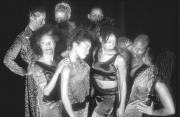Hair Parties
Urban Bush Women led a series of performance-based dialogues called “Hair Parties” in racially and economically diverse neighborhoods of Brooklyn, New York. Using a method of cultural sharing that alternated between dance performance and dialogue, UBW explored how ongoing debates about the politics of hair within the African American community can lead to deeper dialogue about underlying issues of race, class, economics, and history, within and across racial and ethnic groups During the period of January 2002 through March 2003, in living rooms, beauty salons, community centers, restaurants, and theaters in Brooklyn, people were talking about hair. Not just hair, but also race, economic and social status, education, and employment – and not just talking, but also dancing and telling stories. These hair stories – about whether to straighten, curl, color, press, or tease – provided a creative avenue for dialogue about the broader social and political issues that surround hair, particularly natural African American hair. Jawole Willa Jo Zollar, Artistic Director of Urban Bush Women, was inspired to create the multi-media performance HairStories to explore the complex relationship of African Americans to their hair – to explore the concept of “nappy hair” and its relationship to images of beauty, social position, heritage, and self esteem. The Hair Parties project began as a way to collect stories for the HairStories piece and to present scenes from the work in progress in an informal setting. UBW quickly discovered that the parties had the potential to go far beyond collecting and trying out material; they could also provide a creative framework for dialogue that transcended the HairStories performance. Project stakeholders were identified as residents of the adjacent communities of Fort Greene, Clinton Hill, Bedford Stuyvesant, and Park Slope. The first three have large African American populations and significant artists, family, and working class populations. Park Slope is the most racially and economically diverse, and it also has significant family populations as well as a sizeable lesbian and gay community. Framed as parties in order to easily engage people, the Hair Parties took place in settings ranging from living rooms to corporations, and included food and informal time. Each Hair Party was unique, but all incorporated small and large group discussions, performance excerpts that stimulated dialogue, and interactive games to prompt memories and associations from participants.
